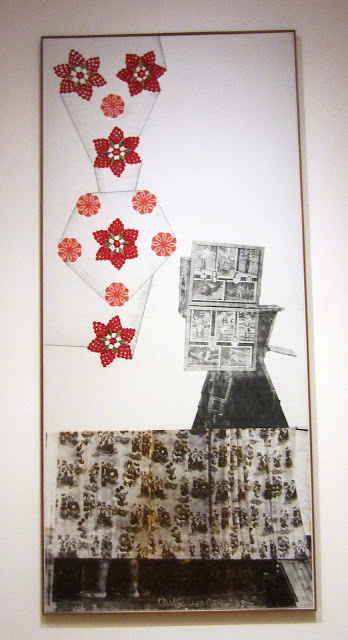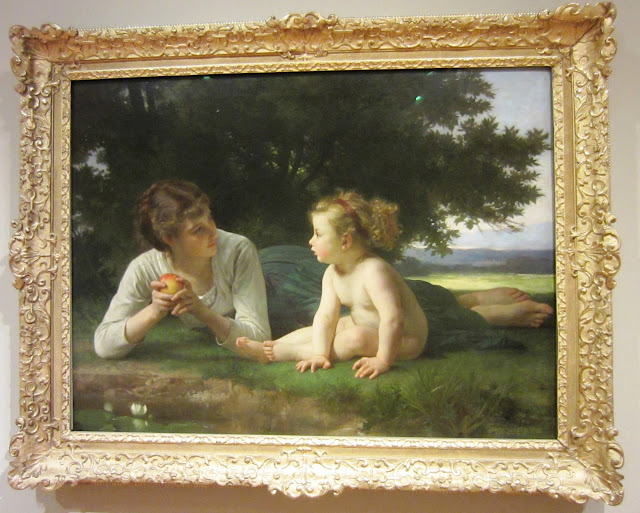It didn't take long to learn that Minnesota is full of surprises, and one of those surprises (at least for me) was how vibrant the art scene is. Much to my husband's dismay, we visited three art museums (if you count the sculpture garden as an art museum, which I do) in Minneapolis.
The surprise within the surprise was the collection of the Minneapolis Institute of Art (MIA).
I guess all art museums are full of surprises, which is what makes them so intriguing, but the MIA had more than its share of surprises.
Did you notice the art in the picture above? That was the first surprise--a bronze body-less head on the front lawn. Eros Bendato Screpolato (1999) by Polish artist Igor Mitoraj is 12 feet long, 7 feet tall, and 4,000 pounds. Translated, the title is something like "Eros in Cracked Bandages." The general feeling of decay and the empty eyes are haunting.
Just down the sidewalk is an angel standing on the back of what looks like a wolf. The work is entitled The Fighter of the Spirit (1928), and is an anti-war piece by German Expressionist artist Ernst Barlach.
Isn't this a great face?
We went from bandaged Eros and a warrior angel to Chinese-style lions greeting visitors near the entrance:
Not even inside, and I was loving the art.
We kicked off our tour with this fellow, The Doryphoros (120-50 BC) carved from marble by an unknown artist. It's a Roman copy of a Greek sculpture made in 440 BC. "Doryphoros" means "spear-bearer." With his left hand and spear missing, I think they had to guess at a name. Couldn't it have just as easily been Bouquet Bearer?
I'm posting the art in the order I photographed it, and this next piece, a giant fiberglass Panda (2002) by Japanese artist Takashi Murakami was a bit of a shock to come upon. It's just so . . . well, shocking, especially when you notice that he is standing on a piece of vintage Louis Vuitton luggage.
The museum label (the labels are exceptionally good here, by the way) notes that "Murakami's distinctive hybrid of Eastern and Western attitudes captures the complexity of a newly global market in which cultures are connected through products. Panda invites us to imagine Murakami's iconic character packing designer luggage with goods sourced from global travels."
Yeah, that's just what I thought when I saw it.
Once I saw that this painting, Flowers (1964), was by Andy Warhol, it seemed obvious, but I wouldn't have guessed that on my own.
There's another shocker coming up. The mama and baby baboon below is actually an assemblage. The mama baboon's head is two toy cars put together. Her torso is a round earthenware pot with high handles that make up her shoulders. Her spine and tail are a coiled spring. The other parts of her body and her baby were molded in clay, and the whole thing was cast in bronze. Any guess who the artist is?
Another artist I've come to know only recently is the Austrian painter Oskar Kokoschka. This is his version of the Cologne Cathedral (1956). He painted this at the cathedral every day for three weeks--except for Sunday--from 9:00 to noon while sitting on a platform suspended from the ceiling so that he could get the angle/view he wanted:
I'd much rather have James McNeill Whistler as a son.
At this point I needed something peaceful and placid, and I found it in Port-en-Bessin (1888) by Frenchman Georges Seurat. Hmmm, a bit pixelated, don't you think?
Or maybe I'm just reading too much into it.
Journey of the Magi (1894) by James Tissot was Bob's favorite painting in all of Minnesota. He did some camel-riding in Egypt and Jordan earlier this year, and these camels, the landscape, and the three men in their saffron robes really resonated with him. I've looked at a print of this online, and I think one day it may become part of our Christmas art collection.
After making three trips to Palestine, Tissot painted a whole series of the life of Christ. I'll be on the lookout for them in other museums.
The explanation for Place du Theatre Fracaise, Paris: Rain (1898) by Camille Pissarro reads: "After a chronic eye infection limited the amount of time Camille Pissarro could spend outdoors, he began a series of views of Paris seen from hotel windows. Hoping to show the beauty of the bustling city, he painted this view down the Avenue de L'opera and other vistas at different hours and seasons, and under varying weather conditions."
Pretty impressive way to make lemonade out of lemons.
Most museums have large collections of "crucifixion art," a very popular theme among artists. This one really stood out for me. Two angels on either side of Christ are catching the blood dripping from his hands in chalices. At the base of the cross is a pelican. The label states, according to a 2nd century AD text, ". . . newborn pelican chicks rebel against their mother, who in turn kills them with her deadly beak. After mourning her offspring's death for three days, the mother pelican is said to open her own chest in order to revive her offspring through her blood. Thus, the pelican scene symbolically mirrors the crucifixion scene."
This sculpture, made of cast bronze, is one of the surprises of the museum. First, it was cast in 1899, MUCH later than I would have guessed. However, the big surprise for me is the artist: John Singer Sargent, the leading portrait painter of his time whose clientele were usually the rich and famous.
Portrait of Beethoven (1902) by German Franz von Stuck, captures so much of the composer's personality. The art label reads, "The intense fields of dark red and off-white color, and the composer's agitated face suggest the emotional impact, and the abyss of violence sometimes opened up by Beethoven's music." This is not a man I would want to take piano lessons from.
But I'd take Fra Angelico's version any day over Madonna and Child Enthroned (1490) by Nicola di Maestro Antonio (di Ancona). This has to be the ugliest Madonna and Babe of all time: Look at Mary's enormous, weirdly-shaped hands! On the other hand, check out the rich brocade of her dress.
However, the art label helped me see it in a different light.
"Having been taken off the cross after his crucifixion, the lifeless body of Christ rests in his mother's lap. John the Evangelist holds his head, while Mary Magdalene looks at his feet, which according to the Gospel of Saint John, she had anointed in the house of Lazarus--an episode referred to by the ointment jar she is holding. Schnatterpeck shows the grief over Christ's death by the furrowed brows of both John and Mary, as well as by the tear on Mary Magdalene's cheek and her desperate gesticulation."
I love this red-headed Mary and young Joseph of this Holy Family (1613) by Spaniard Luis Tristan:
The elongated face of Christ in Christ Driving Money Changers from the Temple (1570) gives away the painter as El Greco. Note the four men in the bottom right corner. Who do you think they are? The four giants of the Renaissance: Titian, Michelangelo, Giulio Clovio, and Raphael.
This is a funeral torch made in Italy in 1720. It's a little creepy:
The Child Baptist in the Wilderness (1776) by British painter Sir Joshua Reynolds gives another unusual view of John the Baptist:
Owning a Dale Chihuly glass sculpture seems to be a requirement for all good museums these days. Sunburst (1999) comprises 1,000 pieces of yellow glass and weighs 3,000 pounds:
This Benediction Scene from late 8th century China is in pretty good condition considering it was carved 1300 years ago:
That's a lot of art, and I think someone is watching us. It's time to move on.



















































The angel sculpture alone is worth the visit. I love that it's by a German.
ReplyDeletePS What an amazing and terrific variety of art!
ReplyDeleteOne of the nicest pieces is the window with Minneapolis in the background! The camel picture is one of my all-time favorites and I don't think I'd noticed the Grant Wood painting of West Branch - very fun.
ReplyDelete